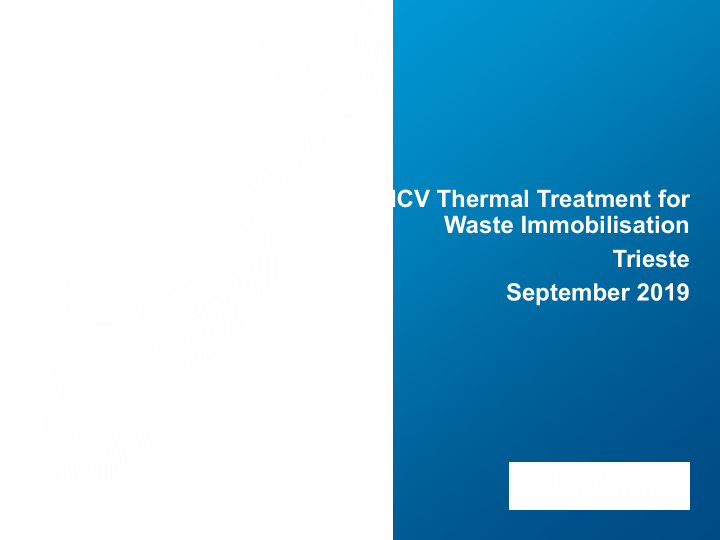



ICV Thermal Treatment for Waste Immobilisation Trieste September 2019
Introduction • Developed at Hanford in the early 1980s • Electric melting of contaminated soils and wastes • Heavy metals and radionuclides are retained in the melt and glass • Organics are destroyed by melt by pyrolysis and combustion • Off-gases are treated with filtration, wet scrubbers, and thermal oxidizer. • Vitrified product suitable for disposal • Installation in NNL Central Lab active area in 2015/16 co-funded by NNL and Veolia • Trials funded through NDA, SL and EU Theramin programme to demonstrate possibilities of ICV treatment on radwastes 2
GeoMelt ICV Layout
GeoMelt ICV Installed in NNL Central Laboratory 4
Melt Demonstrations • Assess thermal treatment as an option for a range of generic waste streams • Demonstration only, no inference for utilisation in UK • Separate programmes of work for NDA (DRP), SL and EU Theramin • Use of active components to assess partitioning throughout the process • Cs-137 • Sr-85 • Natural uranium • Following examples of waste treatment 5
Example 1 Demonstration of Sludge in a Skip • Strategy to immobilise sludge in skip reduces handling • Aim to remove water and then react sludge with frit • Materials batch loaded • Feed While Melt system used to add further material • 2 melts carried out • Inactive surrogate melt • Melt doped with Cs-137 and Sr-85 6
Sludge in a Skip II Operational Data 7
Sludge in Skip Analysis • Major glass forming elements analysed by XRF to assess Activity (Bq/g) homogeneity of melt Sample Cs-137 Sr-85 • Gamma scan used to assess partitioning through the 1B SP 1.1 64.2 56.9 1B SP 1.2 54.4 48.7 process on the active melts 1B SP 1.3 67.0 59.4 • Mg well distributed in block showing immobilisation of 1B SP 2.1 68.5 60.8 sludge feeds 1B SP 2.2 64.0 56.5 1B SP 3.1 64.3 59.4 • A significant proportion of the skip still in metallic form. Not 1B SP 3.2 63.9 56.7 necessarily a problem for disposal 1B SP 3.3 68.3 61.7 • Even distribution of Cs in vitrified product Average 64.3 57.5 • Analysis of off gas suggests little activity reaches SMF and SD 4.5 4.1 may be deposited in plenum. Expected activity 91.5 84.4 Retention rate (%) 70 68 • Materials captured in SMF can be recycled • Optimisation of glass chemistry and melt operation expected to significantly reduce Cs carryover from melt. 8
Example 2 Demonstration of Decommissioning Wastes • Use of ICV to treat miscellaneous wastes arising from future decommissioning • Filter, metals, organics, concrete, scaffolding poles • Soils added as glass forming component Upper photos – waste materials loaded into box Bottom left – box prepared 9
Decommissioning Wastes IR camera showing progression of melt 10
Decommissioning Wastes Product surface active melt (inset Variation diagram of elemental concentration in product inactive melt) 11
Example 3 Uranium Containing Feeds • Aim to demonstrate thermal treatment of surrogates from degraded fuel. • Metallic uranium in a top hat • Key is to assimilate uranium in the melt 12
Uranium Containing Feeds Surface of product (inset previous inactive melt) 13
Uranium Containing Feeds • Iron content not full oxidised • Muon tomography indicates top hat not consumed hindering uranium mixing in the melt (only ca 30% in melt) • Other elements well mixed • Longer melt times at maximum temperature should enhance dissolution and mixing Muon scan of product 14
Example 4 Sea Dump Drums • Aim to demonstrate treatment of conditioned waste such as sea dump drums • Top down melt • Co-processing of sea dump drums and contaminated soil • 36 tins containing grout, aluminium and PVC • Active tracer: 25 MBq Cs-137 • Non-active tracers: Sr and Ce 15
Sea Dump Drums Box Preparation 16
Sea Dump Drums Surface of melt showing surrogate drums 17
Sea Dump Drums Glass Sample Point Cs-137 Activity (Bq/g) SP1.1 anomaly SP2.1 82.8 SP2.2 80.5 SP2.3 82.4 SP3.1 76.5 Mean 80.5 • Gamma spectroscopy at various sample points illustrated good mixing of the radionuclides through the product • Cs retention in the product was measured at 76%, a figure that could be improved with melt optimisation Product surface 18
Summary • A series of demonstration melts have been carried out on a range of nuclear wastes across the NDA estate • The trials have shown the possibility of using an in container vitrification approach to treatment of solid heterogeneous wastes • The fidelity of the results are consistent with one-off trials and it is considered optimisation of melter operation and waste chemistry should process parameters such as radionuclide retention, mass balance etc Acknowledgements: The information summarised here has been extracted from various programmes funded by the Nuclear Decommissioning Authority (NDA), Sellafield Ltd and Theramin, an EU funded Horizon 2020 programme. This project has received funding from the Euratom research and training programme 2014-2018 under grant agreement No 755480. 19
Recommend
More recommend